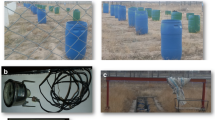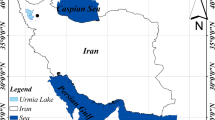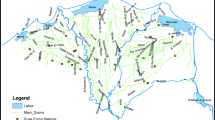Abstract
Wastewater from municipal and industrial sources is becoming increasingly important in being reused, for example, for irrigation purposes. Wastewater is commonly stored in treatment lagoons in which evaporation is the main cause of water loss. Nonetheless, modeling wastewater evaporation (WWE) has received little attention. Driven by this knowledge gap, this study was performed to explore extent to which impurities affect water evaporation. A dimensional analysis was used to formulate WWE as a function of clear water evaporation (CWE), wastewater properties and climatic variables. We based our modeling approach on experimental data collected from the Neishaboor municipal wastewater treatment plant, Iran. As a result of this analysis, a multiplicative model to formulate WWE as a function of the influencing variables is proposed which indicated a reasonably well accuracy (RMSE = 1.09 mm) for the WWE estimation. Clear water evaporation indicated to be the most correlated variable in the model such that a constant coefficient can also be used to estimate WWE from CWE at the cost of losing accuracy only by 4.6 %.









Similar content being viewed by others
References
Allen RG, Pereira LS, Raes D, Smith M (1998) Crop evapotranspiration – guidelines for computing crop water requirements. FAO Irrigation and Drainage Paper 56
Buckingham E (1914) On physically similar systems; illustrations of the use of dimensional equations. Phys Rev 4(4):345–376
Cumba HJ, Hamilton DW (1998) Anaerobic lagoon liquid balance. ASAE Paper No. 98–4115. St. Joseph, Mich.: ASAE. CWQCC. 1997. Confined animal feeding operations control regulation No. 81 (5CCR 1002–81). Denver, Colorado: Colorado Department of Public Health and Environment, Water Quality Control Commission.
Davis S, Fairbank W, Weisheit H (1973) Dairy waste ponds effectively self-sealing. Trans ASAE 16:69–71
Freedman D, Koopman B, Lincoln EP (1983) Chemical and biological flocculation of purple sulfur bacteria in anaerobic lagoon effluent. J Agric Eng Res 28(2):115–125
Ham JM (2002) Seepage losses from animal waste lagoons: a summary of a four-years investigation in Kansas. Trans ASAE 45(4):983–992
Hounam CE (1973) Comparison between pan and lake evaporation. WMO Technical Note no. 126. Geneva, Switzerland, 52 pp
Izady A (2014) Seepage losses estimation from Neishaboor wastewater treatment plant - a water balance study. Report for Khorasan-Razavi Water and Wastewater Company (In Persian)
Izady A, Davary K, Alizadeh A, Ghahraman B, Sadeghi M, Moghaddamnia A (2012) Application of panel-data modeling to predict groundwater levels in the Neishaboor Plain, Iran. Hydrogeol J 20(3):435–447. doi:10.1007/s10040-011-0814-2
Izady A, Davary K, Alizadeh A, Ziaei AN, Akhavan S, Alipoor A, Joodavi A, Brusseau ML (2015) Groundwater conceptualization and modeling using distributed SWAT-based recharge for the semi-arid agricultural Neishaboor Plain, Iran. Hydrogeol J 23(1):47–68. doi:10.1007/s10040-014-1219-9
Kohler MA (1954) Lake and pan evaporation. Water-loss investigations: lake Hefner studies, technical report. US Geol Surv Prof Pap 269:127–149
Kohler MA, Nordenson TJ, Fox WE (1955) Evaporation from Pans and Lakes. US Department of Commerce, Weather Bureau, Research Paper 38
Lapworth CF (1965) Evaporation from a reservoir near London. J Inst Water Environ Manag 19:163–181
Llamas MR, Custodio E (Eds.) (2002) Intensive use of groundwater: challenges and Opportunities. CRC Press
MacDonald DH (2003) The economics of water: taking full account of first use, reuse and return to the environment. CSIRO Report for the Australian Water Conservation and Reuse Research Program
Majidi M, Alizadeh A, Farid A, Vazifedoust M (2015) Estimating evaporation from lakes and reservoirs under limited data condition in a semi-arid region. Water Resour Manag 29(10):3711–3733
Murray FW (1967) On the computation of saturation vapor pressure. J Appl Meteorol 6(1):203–204
Parker DB, Auvermann BW, Williams DL (1999) Comparison of evaporation rates from feedyard pond effluent and clear water as applied to seepage predictions. Trans ASAE 42(4):981–986
Robinson FE (1973) Changes in seepage rate from an unlined cattle waste digestion pond. Trans ASAE 16:95–96
Schofield CP, Rees YJ (1988) Passive separation and the efficiency of anaerobic digestion of cattle slurry. J Agric Eng Res 40(3):175–186
Tilley E, Ulrich L, Luethi C, Reymond P, Zurbruegg C (2014) Compendium of sanitation systems and technologies. 2nd Revised edn. Duebendorf, Switzerland: Swiss Federal Institute of Aquatic Science and Technology (Eawag)
U.S. Department of Commerce (1970) Climatological Summary. Brownsville, Texas, p 46
Webb EK (1966) A pan-lake evaporation relationship. J Hydrol 4:1–11
Wenke TL, Vogt JC (1981) Temporal changes in a pink feedlot lagoon. Appl Environ Microbiol 41(2):381–385
Winter TC (1981) Uncertainties in estimating the water balance of lakes. Water Resour Bull 17:82–115
WTW GmbH, Portable meters for the determination of the parameters pH, ORP, dissolved oxygen, EC. http://www.wtw.com/en/home.html
Acknowledgments
Authors would like to thank the “Khorasan-Razavi Water and Wastewater Company” for the financial support. We also wish to acknowledge the “Neishaboor Water and Wastewater Company” and “Neishaboor municipal wastewater treatment plant” to set-up class A pans and measuring daily wastewater parameters.
Author information
Authors and Affiliations
Corresponding author
Rights and permissions
About this article
Cite this article
Izady, A., Abdalla, O., Sadeghi, M. et al. A Novel Approach to Modeling Wastewater Evaporation Based on Dimensional Analysis. Water Resour Manage 30, 2801–2814 (2016). https://doi.org/10.1007/s11269-016-1324-8
Received:
Accepted:
Published:
Issue Date:
DOI: https://doi.org/10.1007/s11269-016-1324-8




